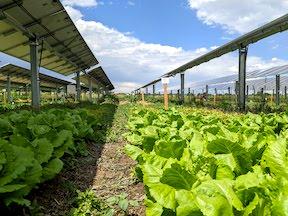
Jack’s Solar Garden in Boulder County, Colo., produces solar power and solar-powered vegetables. Byron Kominek is evaluating the area beneath the panels for cattle grazing as well. The 24-acre farm produced hay and wheat for Kominek’s grandfather Jack.
“We have 3,276 solar panels generating enough electricity for 300 homes,” says Kominek. “The ground beneath the panels produces three times the celery and bok choy grown outside the solar array. Leafy greens also do quite well.”
Jack’s Solar Garden practices agrivoltaics, the combination of agriculture and solar arrays in a mutually beneficial way. Kominek and his family established a non-profit, the Agrivoltaic Learning Center, to help spread the message.
One benefit of agrivoltaics is a cooler microclimate for crops, with less water evaporation from the soil. Sprout City Farms operates 2 1/2 acres under the arrays. Kominek says the farm reports equal yields with half the water compared to full sun vegetable production.
In addition to greens, Sprout City Farms successfully grows tomatoes, turnips, carrots, squash, beets and peppers under and between the panels. Plans are to expand their workforce and crops to include perennials like asparagus and rhubarb, as well as berry plants and bushes.
In addition to Sprout City Farms, the center is working with researchers from the University of Arizona, the National Renewable Energy Laboratory, Colorado State University (CSU) and other partners. They’re evaluating the multi-purpose panels and the benefits they offer.
The standard solar panel in Kominek’s region has an elevation of 4 1/2 ft. at the front (lower) edge. His panels are elevated to 6 ft. for 2/3 of the property and 8 ft. for the remainder. Due to support racks and other hardware, working heights under the panels are actually 2 ft. less.
“It’s easier to work under the taller panels, plus they offer a more homogeneous light diversion than the 6-ft. high panels,” says Kominek. “The panels create a microclimate that’s friendly to farm workers and the crops.”
Even grass grows better than expected under the panels. Colorado State University researchers found the panels decreased brome grass growth by only 9 percent. The panels also provide shelter from the summer sun for the workers in the vegetable beds and grazing animals.
“The Texas Farm Bureau brought a bunch of cattle ranchers up to see our panels,” recalls Kominek. “They didn’t care much for the solar panels until they saw the grass growing underneath them. They realized they could have solar panels and graze cattle beneath them.”
Grazing sheep has proven compatible with solar arrays in many parts of the country. Kominek grazed cattle under his panels, but only temporarily for photos. He wanted to illustrate that cattle and panels could be compatible.
“A solar company would have to design the system appropriately to protect wires and supports,” he says. “We didn’t, and it can’t be done as an afterthought.”
Texas ranchers weren’t the only visitors to the learning center. Kominek reports 1,300 visitors this past year alone, including high school students, state and local policymakers, and interested individuals. “When people come out to the center, they understand what we’re doing and become supporters of the concept,” says Kominek.
The concept for the center has come a long way since Kominek determined his family’s 24 acres weren’t financially viable. County zoning initially prohibited solar arrays. As in many areas, solar arrays are seen as counterproductive to agriculture. Kominek, his family and friends set out to disprove that belief.
After being approved by the county, Kominek set up the 5-acre, 1.2 MW agrivoltaic research site. It’s the largest site of its kind in the U.S., but not unique in other parts of the world.
Japan has more than 1,000 agrivoltaic installations. Germany and France are leaders in the industry, and India and China are adopting the practice. Kominek hopes to see it spread in the U.S.
“I did this because it helped keep our family on the farm,” he says. “We were losing money and had to make a change. Now we’re making more money on the one field with our solar array than we ever did with hay. People think I must be some rich guy, but this was the means to keep our family farm in place.”
Contact: FARM SHOW Followup, Jack’s Solar Garden, 8102 N 95th St., Longmont, Colo. 80504 (ph 970-344-8066; byron@jackssolargarden.com; www.jackssolargarden.com).
